Mauna Loa news - live: Hawaii volcano eruption shifts from summit to rift as shelters open and flights delayed
Hawaii’s Mauna Loa, the largest active volcano on Earth, has erupted for the first time in nearly four decades.
According to the National Weather Service (NWS), the eruption on the state’s Big Island began at approximately 11.30pm local time on Sunday in Mokuaweoweo, the summit caldera of the volcano.
Footage from US Geological Survey (USGS) webcams at the summit captured fountains of lava spewing from a long fissure and spreading across the caldera floor.
The USGS said the lava flows were initially contained in the summit area and do not pose a threat to communities downslope, but there are fears that could change.
At 7.43am ET on Monday, USGS said that “there is currently no indication of any migration of the eruption into a rift zone”.
The eruption has also already triggered dozens of earthquakes of more than 2.5 magnitudes on the Richter scale, one of them clocking in at 4.2.
The local NWS branch issued an ashfall warning which cautioned that “winds may carry volcanic gas and possibly fine ash and Pele’s hair downwind”.
Key Points
Photos show Mauna Loa eruption
Residents shared concerns weeks before eruption
Lava reached sea in under three hours during 1950 eruption
Videos and photos show red glow from volcano eruption
NWS warn people with respiratory illnesses to stay indoors
What happens next?
03:50 , Oliver O'Connell
Each eruption since 1843 started at Mauna Loa’s summit. Half the time, the volcano later also began erupting from vents at lower elevations. The other half of the time it only erupted in the summit caldera.
Scientists can’t tell far in advance when and where Mauna Loa will open new vents and erupt.
Vents generally form along the volcano’s rift zone. That’s where the mountain is splitting apart, the rock is cracked and relatively weak and it’s easier for magma to emerge.
An eruption from vents on the southwest rift zone could hit residential communities, coffee farms or coastal villages on the west side of the island. Lava could reach homes in just hours or days.
The west side’s most populous town would be protected from any Mauna Loa eruption by the presence of another active volcano. The broad flanks of that volcano, Hualalai, sit between Mauna Loa’s southwest rift zone and Kailua-Kona and would block any lava heading toward the coastal community.
An eruption from the northeast rift zone could send lava toward the county seat of Hilo or other towns in East Hawaii. It could take lava weeks or months to reach populated areas on this side of the mountain.
Scott Rowland, a geologist at the University of Hawaii at Manoa, said there’s no pattern when it comes to where an eruption will occur.
“Just because the last one was on the northeast rift zone does not mean the next one will be down the southwest rift zone,” he said.
AP
Why doesn’t Mauna Loa erupt like is neighbour Kilauea
02:50 , Oliver O'Connell
Kilauea is well-known for a 2018 eruption that destroyed 700 homes and sent rivers of lava spreading across farms and into the ocean. The eruption of Mauna Loa is different.
Mauna Loa’s eruptions differ from Kilauea’s in part because it is taller. It’s greater height gives it steeper slopes, which allow lava to rush down its hillsides faster than Kilauea’s.
It’s enormous size may allow it to store more magma, leading to larger lava flows when an eruption occurs.
Frank Trusdell, research geologist at the Hawaiian Volcano Observatory, which is part of the U.S. Geological Survey, said data indicates that Mauna Loa has a much larger magma reservoir than Kilauea, which may allow it to hold more lava and rest longer between eruptions than Kilauea.
AP
Seven weeks ago: National park closes access to Mauna Loa due to increased seismic activity
01:50 , Oliver O'Connell
In early October, national park authorities closed Mauna Loa’s summit off as a precautionary measure “due to elevated seismic activity”.
Shweta Sharma reported for The Independent at the time.

World’s largest active volcano in Hawaii close due to increased seismic activity
Where is Mauna Loa?
00:50 , Oliver O'Connell
Mauna Loa is one of five volcanoes that together make up the Big Island of Hawaii, which is the southernmost island in the Hawaiian archipelago. It’s not the tallest (that title goes to Mauna Kea) but it’s the largest and makes up about half of the island’s land mass.
It sits immediately north of Kilauea volcano, which is currently erupting from its summit crater. Kilauea is well-known for a 2018 eruption that destroyed 700 homes and sent rivers of lava spreading across farms and into the ocean.
Mauna Loa last erupted 38 years ago. In written history, dating to 1843, it’s erupted 33 times.
The Big Island is mostly rural and is home to cattle ranches, coffee farms and beach resorts. It's about 200 miles (320 kilometers) south of Hawaii's most populous island, Oahu, where the state capital Honolulu and beach resort Waikiki are both located.
AP
Southwest Airlines cancels Hilo flights in wake of eruption
Monday 28 November 2022 23:50 , Oliver O'Connell
Southwest Airlines has cancelled at least 10 flights to and from Hilo airport on the Big Island as the eruption of Mauna Loa continues.
The company said in a statement: “The volcanic ash advisory has Southwest adjusting our operation today within Hawaii and we’ll continue reaching to update customers holding reservations on any flights affected by either delays or a cancellation. We have suspended operations in Hilo today, affecting a total 10 interisland departures just on the route between Honolulu and Hilo, and would make further adjustments as necessary.”
A waiver is being offered for customers scheduled to fly to, from or within Hawaii to change their reservation with no changes in fares. The waiver is applicable to bookings Monday and Tuesday.
Aviation officials continue to closely monitor the situation.
One month ago: Hawaii's Big Island gets warning as huge volcano rumbles
Monday 28 November 2022 22:50 , Oliver O'Connell
Authorities warned Hawaii residents to prepare one month ago...
Hawaii officials are warning residents of the Big Island that the world’s largest active volcano, Mauna Loa, is sending signals that it may erupt.
Although an eruption isn’t imminent, scientists are on alert because of a recent spike in earthquakes at the volcano’s summit. Experts say it would take just a few hours for lava to reach homes closest to the volcano, which last erupted in 1984.

Hawaii's Big Island gets warning as huge volcano rumbles
Mauna Loa: What you need to know
Monday 28 November 2022 22:20 , Oliver O'Connell
Mauna Loa is one of five volcanoes that together make up the Big Island of Hawaii, which is the southernmost island in the Hawaiian archipelago.
Mauna Loa, rising 13,679 feet (4,169 meters) above sea level, is the much larger neighbor of Kilauea, which erupted in a residential neighborhood and destroyed 700 homes in 2018. Some of its slopes are much steeper than Kilauea’s, so lava can flow much faster when it erupts.
During a 1950 eruption, the mountain’s lava traveled 15 miles (24 kilometers) to the ocean in fewer than three hours.
Here’s what’s happening at Mauna Loa right now.
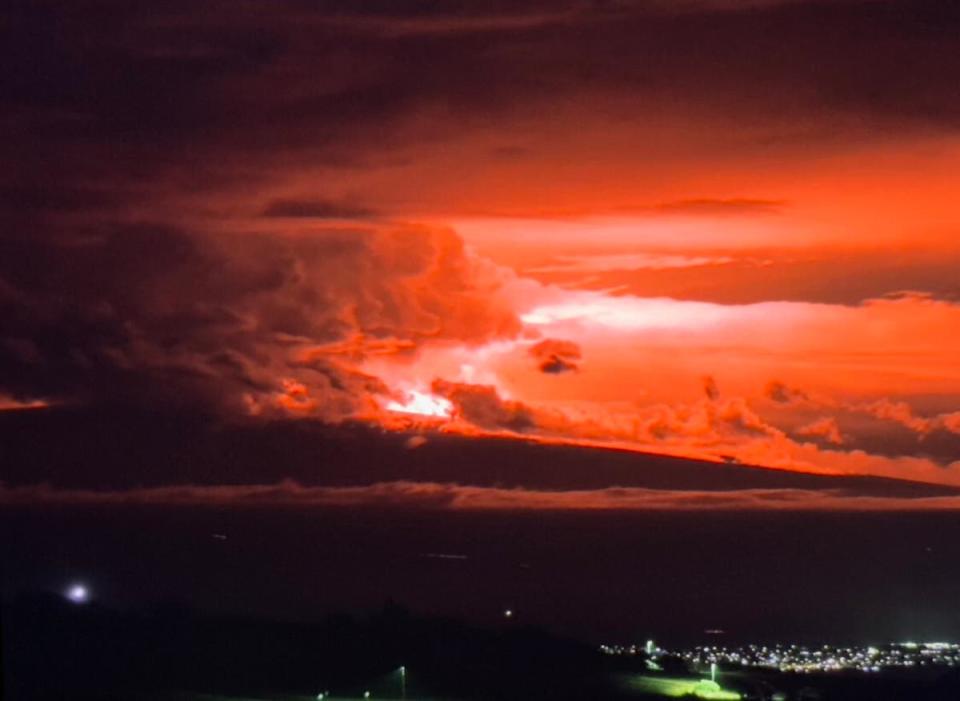
What’s happening at Mauna Loa right now?
Eruption shifts to rift zone
Monday 28 November 2022 21:50 , Oliver O'Connell
The US Geological Survey said that the eruption had migrated to a rift zone — a place where the mountain rock is cracked and relatively weak — making it easier for magma to emerge.
An eruption from the zone could send lava toward the county seat of Hilo or other towns in East Hawaii but it could take the lava weeks or months to reach populated areas.
“We don’t want to try and second-guess the volcano,” Ken Hon, the scientist-in-charge at the Hawaiian Volcano Observatory said. “We have to let it actually show us what it’s going to do and then we inform people of what is happening ASAP.”
Hawaii County Civil Defense announced that it had opened shelters because it had reports of people evacuating from along the coast on their own initiative.
The average Mauna Loa eruption is not typically prolonged, lasting a couple of weeks, Mr Hon said.
“Typically, Mauna Loa eruptions start off with the heaviest volume first,” Mr Hon said. “After a few days, it starts to calm down a little bit.”
In pictures: Lava flow in caldera of volcano
Monday 28 November 2022 21:20 , Oliver O'Connell
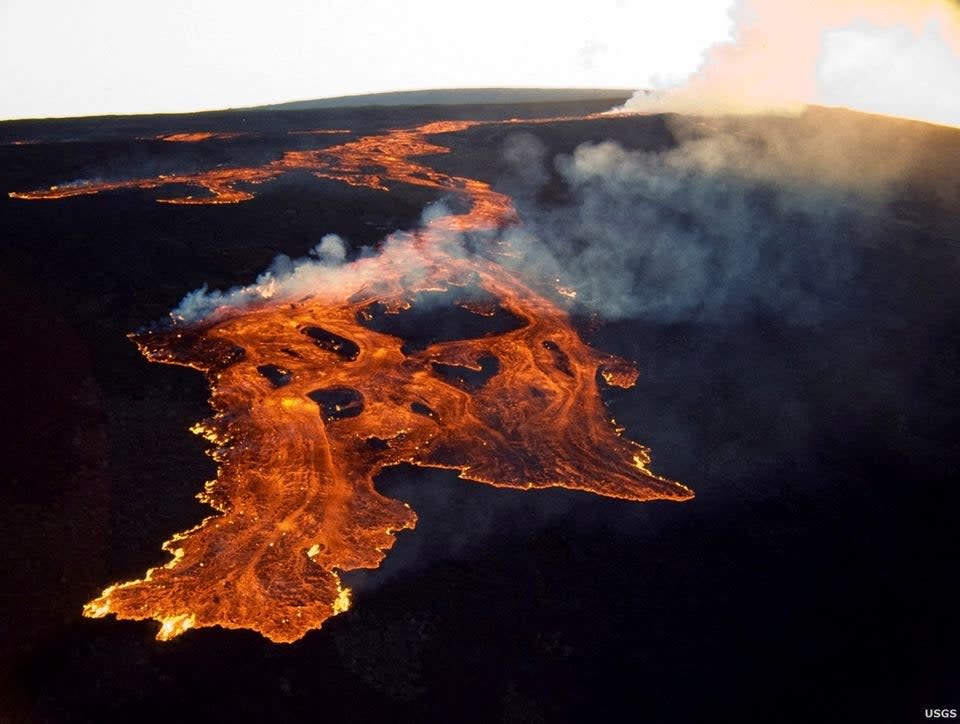
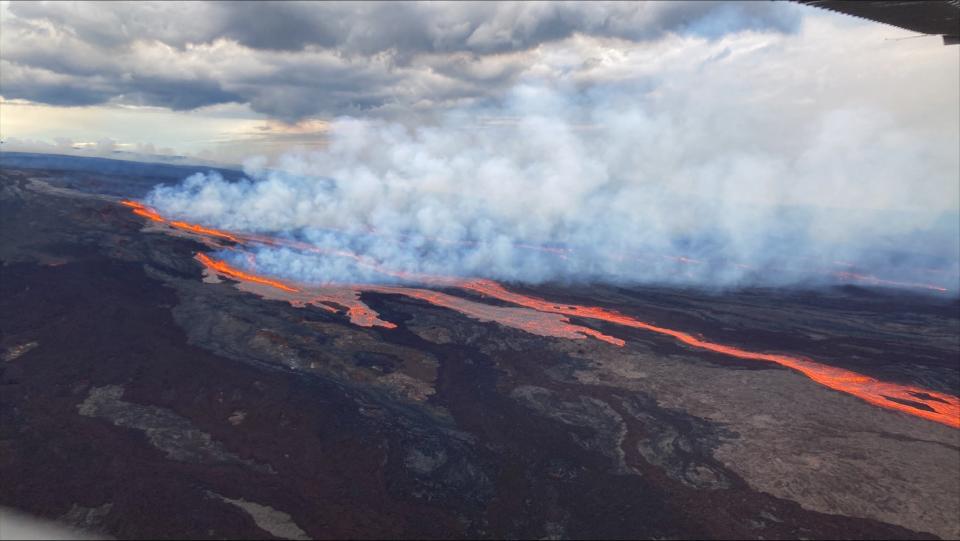
How many people are in danger?
Monday 28 November 2022 20:57 , Oliver O'Connell
Although there is no immediate danger to communities on Hawaii’s Big Island, officials have warned residents to be ready for the worst.
Many current residents weren’t living there when Mauna Loa last erupted 38 years ago. The US Geological Survey warned the roughly 200,000 people on the Big Island that an eruption “can be very dynamic, and the location and advance of lava flows can change rapidly.”
The eruption began late Sunday night following a series of fairly large earthquakes, said Ken Hon, the scientist-in-charge at the Hawaiian Volcano Observatory.
There’s been a surge of development on the Big Island in recent decades — its population has more than doubled, from 92,000 in 1980.
Most of the people on the island live in the city of Kailua-Kona to the west of the volcano, which has about 23,000 people, and Hilo to the east, with about 45,000. Officials were most worried about several subdivisions about 30 miles to the south of the volcano, which are home to about 5,000 people.
AP
Stunning pictures of eruption at sunrise
Monday 28 November 2022 20:37 , Oliver O'Connell
Twitter users have posted stunning pictures of the eruption at sunrise on Monday morning.
From Hilo pic.twitter.com/lbA7Ma8Q9G
— Cbreez808 🌴🩴🌸♐️#FinZup🐬🐬🐬 (@Cbreez808) November 28, 2022
Residents encouraged to know their inundation zone and plan ahead
Monday 28 November 2022 20:00 , Oliver O'Connell
Hawaii County is encouraging residents to check an interactive map of potential lava inundation zones that could be impacted as the eruption progresses from vents upslope.
A further map helps residents identify their property’s hazard zone. These zones are used to understand the long-term likelihood of lava flow coverage and are numbered between one and nine. Zone 1 is the most hazardous and it includes summit and rift zone areas where eruptions have occurred repeatedly.
Dramatic photos of the lava flows
Monday 28 November 2022 19:40 , Oliver O'Connell
There are dramatic new photos of the lava flows out of the northeast rift zone of Mauna Loa from a Civil Air Patrol flight. So far, the lava does not pose a threat to residents.
#BREAKING: Mauna Loa is erupting.
The lava at this time does not pose a threat to residents, but it is flowing downslope to the north from vents on the Northeast Rift zone.
Stay with https://t.co/tYuhmvM9U5 for the latest updates.#HawaiiNews pic.twitter.com/salSGMZaej— Hawaii News Now (@HawaiiNewsNow) November 28, 2022
Hawaii transport agency issues guidance to air travellers
Monday 28 November 2022 19:25 , Oliver O'Connell
The Hawaii Department of Transportation has issued guidance to air passengers in light of the eruption of Mauna Loa as the situation develops.
Hawaii Island Passengers with flights to Hilo International Airport (ITO) or the Ellison Onizuka Kona International Airport at Keahole (KOA) should check with their airline prior to heading to the airport due to the volcanic activity at Mauna Loa.
Hawaii Island #hiwx Passengers with flights to Hilo International Airport (ITO) or the Ellison Onizuka Kona International Airport at Keahole (KOA) should check with their airline prior to heading to the airport due to the volcanic activity at Mauna Loa.
— Hawaii DOT (@DOTHawaii) November 28, 2022
What we know so far about the eruption of the world’s largest active volcano
Monday 28 November 2022 19:10 , Oliver O'Connell
The eruption of Mauna Loa, the volcano’s first in nearly four decades, has triggered dozens of earthquakes of more than 2.5 magnitude on the richter scale, one of them clocking in at 4.2.
According to the Hawaiian Volcano Observatory, the eruption began at approximately 1.30pm Hawaii time on Sunday night.
Here’s what we know so far:

World’s largest active volcano erupts
Civil defence shelters opened as precaution
Monday 28 November 2022 18:45 , Oliver O'Connell
While there is no threat to downslope communities yet, an early morning update from the County of Hawaii Civil Defense Agency states that as the eruption of Mauna Loa has migrated from the summit to the Northeast Rift Zone, two shelters are opening as a precautionary measure.
Full Report: https://t.co/8BHk5b3ZP8 pic.twitter.com/Ij6cMloyTs
— COH Civil Defense (@CivilDefenseHI) November 28, 2022
View of eruption at 715am local time
Monday 28 November 2022 18:20 , Oliver O'Connell
USGS Volcanoes notes that the eruptions have shifted into a different rift zone.
Another view of the Mauna Loa eruption from Waikoloa at about 6:15AM. Eruptions have moved into the Northeast Rift Zone. #MaunaLoa #MaunaLoaErupts @Volcanoes_NPS @CivilDefenseHI @Hawaii_EMA pic.twitter.com/Ot4JPznQyV
— USGS Volcanoes🌋 (@USGSVolcanoes) November 28, 2022
The agency notes that the early stages of an eruption of Mauna Loa can be very dynamic.
This map is based on Mauna Loa eruptions over the past 200 years and shows how quickly lava flows can reach populated areas. Based on past events, the early stages of a Mauna Loa eruption can be very dynamic so stay tuned for more information. pic.twitter.com/71JmlHrEQh
— USGS Volcanoes🌋 (@USGSVolcanoes) November 28, 2022
How are volcanic eruptions impacted by climate change?
Monday 28 November 2022 17:55 , Oliver O'Connell
While the eruption of Mauna Loa is a rare occurrence, the climate crisis could lead to more volcanic activity, some scientists say.
The greenhouse gas emissions heating the planet are melting glaciers and in turn destabilizing mountains, creating conditions for volcanic eruptions that were previously restrained.
“Imagine the ice like some sort of protective layer – when the ice melts away, the mountain is free to collapse,” Gioachino Roberti, a PhD student researching volcanic activity at the University of Clermont Auvergne, previously told The Independent. “If your mountain is a volcano you have another problem. Volcanoes are a pressurised system and if you remove pressure by ice melting and landslide, you have a problem.”
Louise Boyles reports.

How does climate change impact volcanic eruptions?
‘Slow buildup’ to eruption was recognised by authorities
Monday 28 November 2022 17:25 , Oliver O'Connell
Asked whether there were signs that the eruption was coming, the USGS Volcanoes Twitter account replied: “Activity has definitely been elevated for months - enough that HVO started holding community meetings in potentially impacted areas to ensure that residents knew the hazards and what to expect. Onsets are always very rapid at Mauna Loa, but the slow buildup was recognized.”
Were there signs that this was coming or was it a complete surprise?
— Festive Lisa (@totallynotlisa) November 28, 2022
Activity has definitely been elevated for months - enough that HVO started holding community meetings in potentially impacted areas to ensure that residents knew the hazards and what to expect. Onsets are always very rapid at Mauna Loa, but the slow buildup was recognized.
— USGS Volcanoes🌋 (@USGSVolcanoes) November 28, 2022
Videos show first Mauna Loa eruption in 38 years
Monday 28 November 2022 16:55 , Gustaf Kilander
Ahead of eruption, Hawaii resident says lower-income areas would be affected most
Monday 28 November 2022 16:35 , Gustaf Kilander
Last month, before the Mauna Loa eruption, Ocean View, Hawaii resident Joel William Rogers told Newsweek that lower-income areas would be the most affected by a possible eruption.
“Often my friends from the mainland who follow the news get the idea that it’s a tiny island and everyone will be covered by lava or something dramatic like a Hollywood film. In reality, all the recent lava flows have been close to a hundred miles from where I live. I was a part of a lava evacuation team during the 2014 [KÄ«lauea] eruptions in Puna, Hawaii. That was quite dramatic to have lava taking out houses. Again, all of that was about a three-hour drive from my home,” Mr Rogers told the magazine in October. “I am grateful that national news media seems to notice and talk about it when we have natural disasters like lava, tsunamis or hurricanes here in Hawaii. I know many parts of the world that go unmentioned despite much greater suffering.”
Photos show Mauna Loa eruption
Monday 28 November 2022 16:15 , Gustaf Kilander
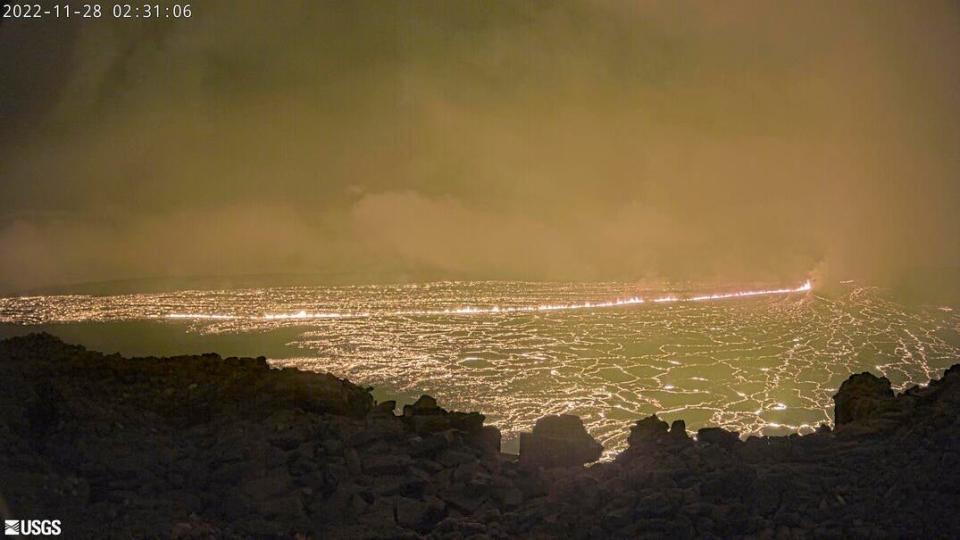
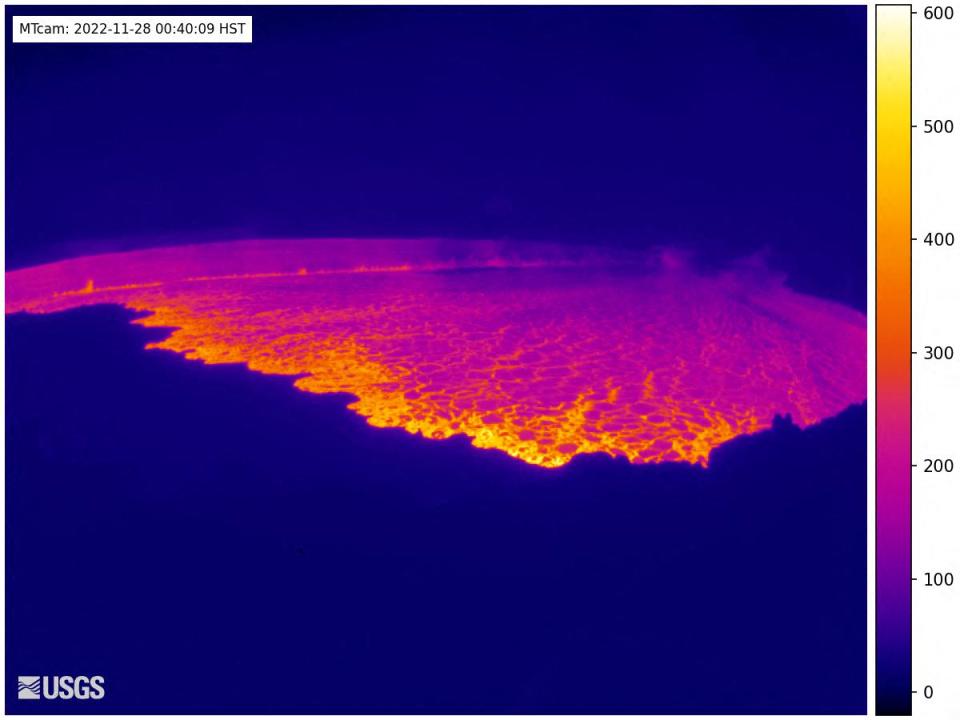
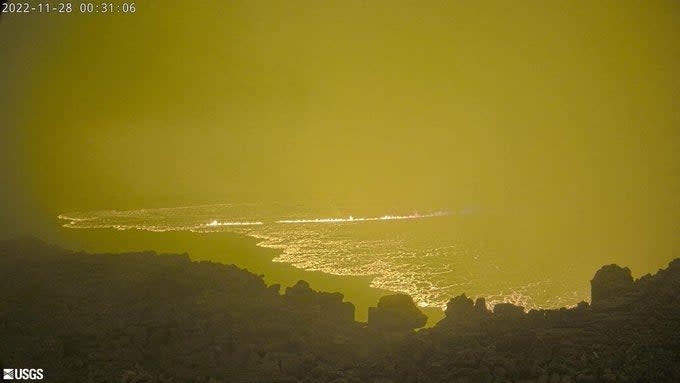
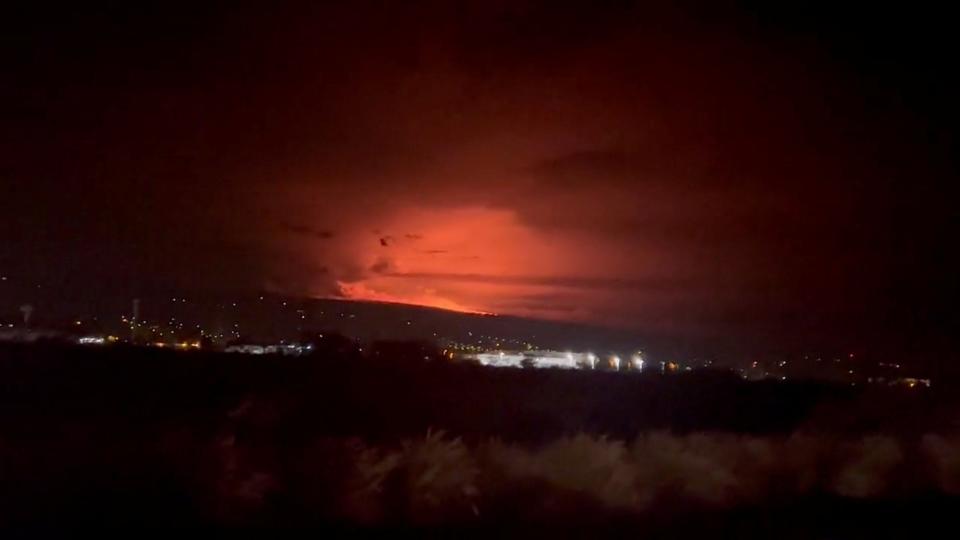
Residents shared concerns weeks before eruption
Monday 28 November 2022 15:55 , Gustaf Kilander
Hawaii residents were worried about a possible eruption weeks before it happened.
“We are concerned. We haven’t thought too much about the volcano, even in 2018 when an [KÄ«lauea] eruption happened on the east side of the island. We knew it would not touch our homes,” resident Laura Roberts told Newsweek last month.
“Here in Ocean View, [Mauna Loa’s] lava could reach the ocean in less than three hours and our homes faster than that. We are on the rift zone so fissures could open. It’s a weird feeling to know that there is a possibility of losing your home. It also makes us feel like we should not travel because what if something happens and we can’t evacuate our important things and animals,” she added at the time.
Lava reached sea in under three hours during 1950 eruption
Monday 28 November 2022 15:35 , Gustaf Kilander
Mauna Loa is one of five volcanoes making up the Big Island of Hawaii – the island furthest to the south in the Hawaiian archipelago.
The volcano reaches 13,679 feet (4,169m) over the sea and sites beside the smaller Kilauea volcano.
Kilauea erupted in 2018, destroying 700 homes, according to the Associated Press.
Some of the slopes on Mauna Loa are steeper than those of Kilauea, meaning that lava can travel faster.
When it erupted in 1950, the lava went 15 miles (24km), hitting the ocean in under three hours.
Videos and photos show red glow from volcano eruption
Monday 28 November 2022 15:15 , Gustaf Kilander
Mauna Loa, the largest active volcano on Earth, erupted late Sunday, casting a red glow in the skies over Hawaii's Big Island. https://t.co/dYyOuGKDI2 pic.twitter.com/H84y696iLA
— ABC News (@ABC) November 28, 2022
Mauna Loa is erupting for the first time in nearly four decades on the Big Island of Hawaii. The USGS has more on what is happening and may happen next. (It's difficult to predict. The skies are rather omninous in Kailua-Kona.https://t.co/tuP5Sv2rBZ https://t.co/fHjE0tC9CJ
— Eric Berger (@SciGuySpace) November 28, 2022
NWS warn people with respiratory illnesses to stay indoors
Monday 28 November 2022 14:55 , Gustaf Kilander
The National Weather Service in Honolulu has warned those with respiratory illnesses to stay indoors.
“People with respiratory illnesses should remain indoors to avoid inhaling the ash particles and anyone outside should cover their mouth and nose with a mask or cloth,” the service said. “Possible harm to crops and animals. Minor equipment and infrastructure damage. Reduced visibility. Widespread clean-up may be necessary.”
The Hawaiian Volcano Observatory said that “based on past events, the early stages of a Mauna Loa eruption can be very dynamic and the location and advance of lava flows can change rapidly”.
“If the eruption remains in Moku’Äweoweo, lava flows will most likely be confined within the caldera walls,” the observatory said. “However, if the eruptive vents migrate outside its walls, lava flows may move rapidly downslope.”
Hawaii Tourism Authority says no flights affected so far amid ashfall alert
Monday 28 November 2022 14:35 , Megan Sheets
In an update Monday morning, the Hawaii Tourism Authority said that no flights have been affected thus far by the Mauna Loa eruption that began hours earlier.
“We are closely monitoring the eruption of MokuÊ»Äweoweo, which is not currently threatening communities downhill or affecting flights to the Island of HawaiÊ»i,” the Twitter update read.
However, the organisation later reshared a warning from the Hawaii Emergency Management Agency about ashfall.
“Up to a quarter-inch of ash is expected around and downwind of Mauna Loa,” it read. “People with breathing difficulties should stay indoors, and cover nose/mouth with cloth or a mask.”
Below is a map of where the eruption is taking place:
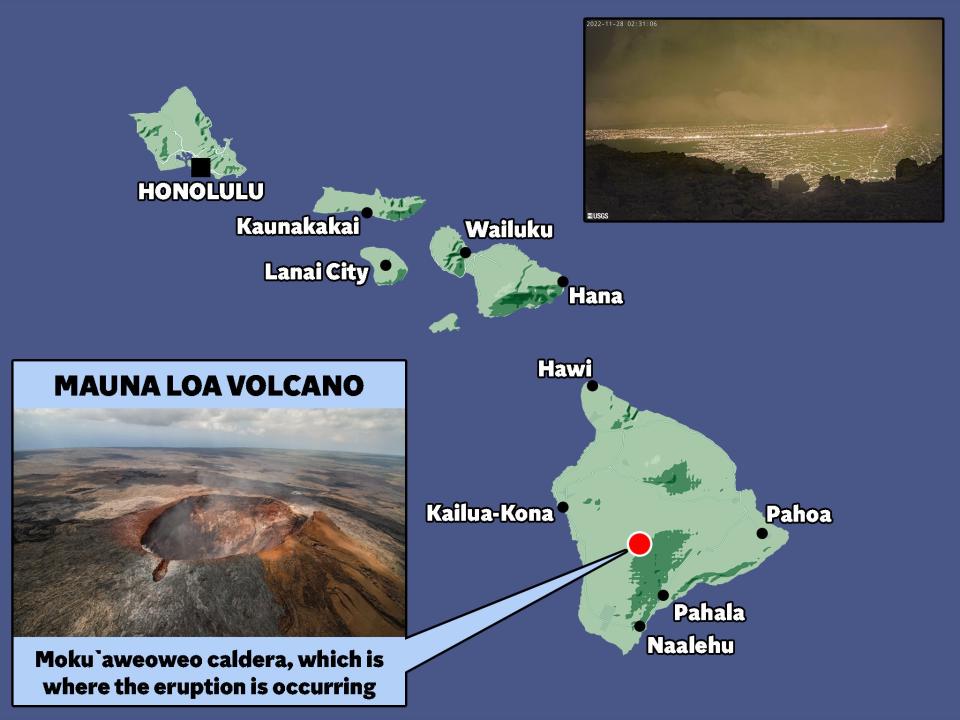
Mauna Loa is home to critical global CO2 monitoring site
Monday 28 November 2022 14:15 , Louise Boyle
On the north flank of the Mauna Loa Volcano sits the observatory holding the longest record of carbon dioxide (CO2) measurement in the atmosphere.
The measurements, started in 1958 by Charles David Keeling, a scientist with the Scripps Institution of Oceanography at a National Oceanic and Atmospheric Administration facility, have been integral to the world’s understanding of the climate crisis.
The Mauna Loa Observatory is 11,135 feet above sea level making it an ideal location for gathering the data because of its remoteness from people and vegetation, and relatively undisturbed air.
CO2 is being pumped into the atmosphere mainly from burning fossil fuels. This heating of the planet is leading to increases in sea level rise and more extreme impacts like wildfires, floods and storms.
The last measurement of global daily CO2 was 418.05 parts per million (ppm) on 27th November, 2022 - and it continues to rise.
PPM refers to how many parts of carbon dioxide there are in one million parts of air. Climate scientists have suggested that around 350ppm would be a safe level of CO2 in the atmosphere.
Warnings issued for weeks prior to eruption
Monday 28 November 2022 13:55 , Megan Sheets
Warnings began to be issued part way through September when geologists began to record an uptick in the number of earthquakes trembling below the surface of Mauna Loa.
For a typical day in mid-September, the site was experiencing approximately 20 quakes a day, but that number shifted up to 40 by the beginning of October.
In response to this shift in seismic activity, the US Geological Survey Hawaiian Volcano Observatory updated its advisory level from green to yellow out of precaution for the volcano’s “heightened unrest”.
In this four-tier advisory system, green is the lowest and equates to normal activity; yellow intimates that the “volcano is exhibiting signs of elevated unrest above known background activity”; orange is watch and means that there is “escalating unrest with increased potential of eruption”; and red means an eruption is “imminent, underway, or suspected”.
In October, the summit of Mauna Loa was closed to tourists in light of the heightened activity out of what the NPS called “a precautionary measure”.
Thermal image shows lava streaming from caldera fissure
Monday 28 November 2022 13:35 , Megan Sheets
The USGS released a thermal image that shows lava streaming from a long fissure in Mauna Loa’s caldera.
Thermal image of Mauna Loa eruption acquired at midnight HST.
Information statement at https://t.co/o5T7dc62Ls. pic.twitter.com/lV1cdOKPqm— USGS Volcanoes🌋 (@USGSVolcanoes) November 28, 2022
The photo was accompanied by a summary statement from the agency:
“At approximately 11:30 p.m. HST this evening, November 27, an eruption began in Moku‘Äweoweo, the summit caldera of Mauna Loa, inside Hawai‘i Volcanoes National Park. At this time, lava flows are contained within the summit area and are not threatening downslope communities. Winds may carry volcanic gas and possibly fine ash and Pele’s hair downwind.
“Residents at risk from Mauna Loa lava flows should review preparedness and refer to Hawai‘i County Civil Defense information for further guidance.
“Based on past events, the early stages of a Mauna Loa eruption can be very dynamic and the location and advance of lava flows can change rapidly.
“If the eruption remains in Moku‘Äweoweo, lava flows will most likely be confined within the caldera walls. However, if the eruptive vents migrate outside its walls, lava flows may move rapidly downslope.
“HVO is in close consultation with emergency management partners and will be monitoring the volcano closely to provide further updates on activity. As soon as possible, HVO will conduct aerial reconnaissance to better describe the eruption and assess hazards.”

 generic
generic 